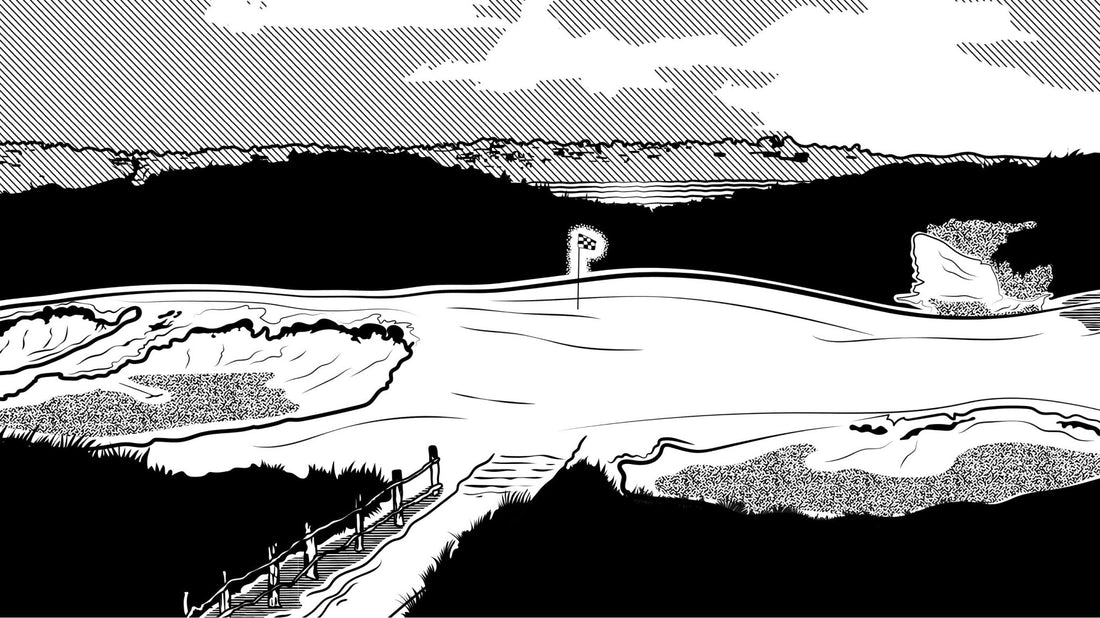
Under Your Influence: Vol 1
Share
As a designer and illustrator I pull inspiration and influence from all kinds of places. 99.9% of them are from places completely foreign to golf (at least as it used to be). A big part of my visual journey to this point has been due to some key names I want to share with you, shed a bit of light on, and hopefully it sparks you to seek out some of their work. Here’s the first few names…
Keith Haring
Keith Haring has an unmistakable style entirely of his own. Even without being artistically minded one could absolutely pick his work out from a line up. Over the last couple of decades since his death, many many brands have collaborated with the Keith Haring Foundation on collections. Most notably for golfers, Malbon.

Image respectfully acquired via Keith Haring Foundation
What drew me to his artwork when I was young was simply how bold it was. Thick outlines, artwork bursting with colour and movement and expression. As I got older I grew to appreciate his activism and awareness, often speaking out on social issues such as AIDS, literacy programs and other public service initiatives. His love for his community and city was really admirable. Another big inspiration is Haring’s spontaneous subway drawings where he would use chalk to create artwork on vacant subway poster panels throughout the New York subway system and a way to communicate effectively.
In 2014 I was lucky enough to see his political works on display in San Francisco when visiting the US. I was blown away by the volume of the work, not just in numbers but scale, motivation and what he was saying. Some of his larger scale works are so complex you can easily get lost looking at all of the smaller detail in these seemingly simple images.

A photo I took at the exhibition of political works at De Jong Museum in San Francisco, 2014
Spoiler
A huge part of my life has been punk and hardcore music. When I stopped playing golf at 21 it was because I’d fallen in love with the local punk/hardcore scene in Brisbane. Finally I felt like I had found a like minded community that embraced me for who I am. My childhood love for golf quickly faded as I felt less and less engaged with my club. As I started to get tattooed, comments started to fly my way. In 2003 it was still on the fringes to have exposed tattoos generally, let alone at a golf club.
One of my all time favourite artists from hardcore is Spoiler. His style is unmistakably his and the way he creates complex compositions really gets me. Certainly something I have often tried to little success. His work and the work of other hardcore artists drew me back to illustration while playing in bands. Creating merch, flyers and covers for mix tapes and demos for myself or friends.

He’s done artwork for a tonne of my favourite bands including Mental, Backtrack, Justice (not the EDM group… the amazing Belgian hardcore band), Shark Attack, Terror, Iron Boots, Dead Stop and so many more. If you’re into fast music I urge you to seek every one of these bands out and check out his art.
Mike Giant
I played in a band with a mate who was all of a sudden rocking this killer looking tattoo/graffiti inspired streetwear by a brand called Rebel 8 in the early 2010s. By then I had fallen in love with the streetwear ethos of small and limited. Reminded me a lot of the hardcore scene in ways. If you know, you know. What my friend was wearing was always in black and white, bold outlines and super crisp illustrations. I then came to understand this was the artwork of the one Mike Giant.
A former architecture student, graffiti artist and tattooist he has managed to coalesce these skills in their own right to a super distinctive style. Giant uses photographic references of streetscapes, posed models, cars etc. Then goes over the top injecting the scenes and people with graffiti and tattoos. Also an incredible letterer and graffiti writer he also includes fantastic typographic elements.

Giant’s method of work has become a huge inspiration to me in my style. In design college I chose him as a reference for an assignment in which we had to replicate not only how an illustration would look but use their method as well. It’s where my process for my scenes comes from, though completely digital. His involves a light box and sharpie… I don’t have the hands for that.

R Kikuo Johnson
The most recent of my creative references is R Kikuo Johnson who I stumbled across on a Pinterest raid 3-4 years ago. I was filling out my Illustration board as I do and these stunning illustrations of The Masters came up. He’d done illustrations for Golf Digest where he’d been sent to capture the tournament through his interpretation.

The way Johnson uses colour has been a big inspiration for me on how I’ve understood how I can best use it in my work. Growing up I was all about black and white, my early illustrations of holes are evidence of that, and why I am drawn so much toward people like Mike Giant and Stellar Leuna (amazing illustrator from Sydney - seek her work out, and listen to her band Potion) are massive evidence of that also.
Observing illustrators like R Kikuo Johnson and others in the same stylistic sandbox has helped open my eyes up to new possibilities and ways to push my work further. Rather than just using light and shade – being able to work in the subtlety of colour while keeping things bold and illustrative like I prefer to.

DKNG Studios
The last but most certainly not least for this list are the giant that is DKNG studios. When I was studying design these guys first came across my radar. Being vector illustrators they were already right up my alley, but I had never considered using texture in such a clean design program. They opened my eyes to the technical side of digital illustration with their brilliant process videos, use of brushes and texture packs, and how to layer real world texture to bring what would otherwise be flat artwork to life.


It’s funny, the shortest write up in this list has maybe had the most significant impact on me as a professional. What observing their work has given me as a professional… vision to sell prints, try and experiments and styles, see what works and what doesn’t… all the way down to the nitty gritty of file set up and composition. It’s good, good stuff.
